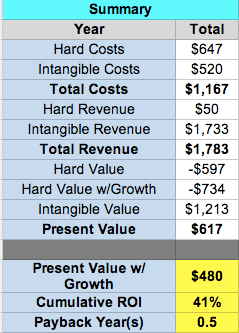
I wanted to start with this example for two reasons. One, because nobody is really getting excited about air drying their laundry. And two, because this is a pretty straightforward example that will help familiarize you with my approach. Okay, enough talk, here are the stats:
Scenario: Use an electric dryer versus manually air drying your clothes
- 10 Year NPV: $480
- 10 Year ROI: 41%
- 10 Year Payback: 0.5 years
Calculations Summary:

Commentary:
So it appears that using a drying machine is actually cheaper than air drying your clothes (lazy people rejoice!). Air drying your clothes would cost you roughly $500 over ten years versus using a drying machine. If you take a closer look you will notice that the key driver is the intangible cost, which is time in this example.
Here is how the time calculation works. I estimated that free time is worth about $10 per hour and that air drying your laundry will take an extra 7 minutes per load. This works out to a little over $1 per load of laundry. Based on personal experience, $10 per hour is my standard time cost estimate; however, each person will place a unique value on their time depending on factors such as current income, free time, goals, preferred activities, etc. (That is why I include the spreadsheet link for customization.)
The rest of the assumptions are outlined below, but the main thrust of the analysis is that even though you save on energy and equipment costs, you end up spending a lot more time doing laundry when you air dry, time that you could be putting to more productive use. Even if you threw out the drying machine completely in favor of drying racks, you would still be barely in the red after 10 years.
One last thing to point out though is that the cost of air drying your laundry over 10 years isn’t that much; an average cost $50 per year is almost negligible. If you simply enjoy the ritual of hanging clothes on a clothesline, love the smell and feel of air-dried laundry, or have ethical reservations about your carbon footprint, then I wouldn’t feel too guilty about cheating on your drying machine every now and then… Just do what you do and do it good.
Assumptions:
- Replace dryer every 26 years for $600 (source: best buy and get rich slowly ; timeframe doubled due less wear and tear)
- Single person household does two loads of laundry a week (source: estimate)
- Two drying racks every 10 years at $25 each (source: amazon)
- Each dryer cycle costs $0.40 (source: mr. electricity)
- Putting clothes on a drying rack takes an extra 7 minutes (source: estimate)
- Your time spent hanging clothes on the drying rack is with $10 per hour
- Real rate of return, adjusted for inflation, averages 4% over 10 years
————————————–
Updates:
Commenter Steve K. makes a great point below about interpreting the situation more completely. In theory, air-drying your clothes should increase their lifespan, saving you some extra scratch in the long run. Based on the pretty conservative numbers discussed, $200 in clothing per person per year and a 25% longer clothing lifespan not using a dryer, this would indeed mean that air drying your clothes is a better decision if you agree with all other assumptions above. However, it would still be a pretty modest ROI, but these appear to be conservative estimates.
So this is probably a good time to discuss how I plan to use these analyses and how I hope readers will interpret them. Each analysis will only be as good as the accuracy and completeness of its assumptions. My aim is to make some reasonable assumptions and have generally or directionally accurate results. Of course, fourth decimal place precision would be really nice, but the amount of work required to achieve that level of confidence is not within the scope of this blog.
So for this scenario, the directionally or generally accurate results indicate that air drying your laundry is almost a break-even undertaking over 10 years. Depending on how you want to tweak the set of assumptions, it could go slightly positive or slightly negative, but if I haven’t missed or poorly estimated any key variable, it shouldn’t all of a sudden turn out that air drying your laundry is wildly profitable versus drying machines (note to self: don’t come on as strong in post titles when margin of error is slim).
Sometimes, however, when good data isn’t available, my assumptions might be pretty different than the reality or yours, and I see that as okay; it comes with the territory. Things such as estimating the income equivalent from having a steady romantic relationship in your life, for example, would be pretty thorny. But I don’t plan on getting that abstract early on; we’ll stick to the practical and tangible first. Another example of a difficult variable to estimate is risk, which is why I probably won’t include it too frequently either.
With all that said, I am here to learn and share. If I miss the mark completely, I plan to go in and update the analysis. I won’t be able to update every post that has a new twist to it, but If readers have insightful points to share, I will share them at the bottom of each article. My goal is directional accuracy and also getting you information that can help make more informed decisions.